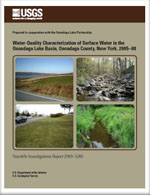Water-resources managers in Onondaga County, N.Y., have been faced with the challenge of improving the water-quality of Onondaga Lake. To assist in this endeavor, the U.S. Geological Survey undertook a 3-year basinwide study to assess the water quality of surface water in the Onondaga Lake Basin. The study quantified the relative contributions of nonpoint sources associated with the major land uses in the basin and also focused on known sources (streams with large sediment loads) and presumed sinks (Onondaga Reservoir and Otisco Lake) of sediment and nutrient loads, which previously had not been evaluated.
Water samples were collected and analyzed for nutrients and suspended sediment at 26 surface-water sites and 4 springs in the 285-square-mile Onondaga Lake Basin from October 2005 through December 2008. More than 1,060 base-flow, stormflow, snowmelt, spring-water, and quality-assurance samples collected during the study were analyzed for ammonia, nitrite, nitrate-plus-nitrite, ammonia-plus-organic nitrogen, orthophosphate, phosphorus, and suspended sediment. The concentration of total suspended solids was measured in selected samples. Ninety-one additional samples were collected, including 80 samples from 4 county-operated sites, which were analyzed for suspended sediment or total suspended solids, and 8 precipitation and 3 snowpack samples, which were analyzed for nutrients. Specific conductance, salinity, dissolved oxygen, and water temperature were periodically measured in the field.
The mean concentrations of selected constituents in base-flow, stormflow, and snowmelt samples were related to the land use or land cover that either dominated the basin or had a substantial effect on the water quality of the basin. Almost 40 percent of the Onondaga Lake Basin is forested, 30 percent is in agricultural uses, and almost 21 percent, including the city of Syracuse, is in developed uses. The data indicated expected relative differences among the land types for concentrations of nitrate, ammonia-plus-organic nitrogen, and orthophosphate. The data departed from the expected relations for concentrations of phosphorus and suspended sediment, and plausible explanations for these departures were posited. Snowmelt concentrations of dissolved constituents generally were greater and those of particulate constituents were less than concentrations of these constituents in storm runoff. Presumably, the snowpack acted as a short-term sink for dissolved constituents that had accumulated from atmospheric deposition, and streambed erosion and resuspension of previously deposited material, rather than land-surface erosion, were the primary sources of particulate constituents in snowmelt flows.
Longitudinal assessments documented the changes in the median concentrations of constituents in base flows and event flows (combined stormflow and snowmelt) from upstream to downstream monitoring sites along the two major tributaries to Onondaga Lake - Onondaga Creek and Ninemile Creek. Median base-flow concentrations of ammonia and phosphorus and event concentrations of ammonia increased in the downstream direction in both streams. Whereas median event concentrations of other constituents in Onondaga Creek displayed no consistent trends, concentrations of ammonia-plus-organic nitrogen, orthophosphate, phosphorus, and suspended sediment in Ninemile Creek decreased from upstream to downstream sites. Springs discharging from the Onondaga and Bertie Limestone had measureable effects on water temperatures in the receiving streams and increased salinity and values of specific conductance in base flows.
Loads of selected nutrients and suspended sediment transported in three tributaries of Otisco Lake were compared with loads from 1981-83. Loads of ammonia-plus-organic nitrogen and orthophosphate decreased from 1981-83 to 2005-08, but those of nitrate-plus-nitrite, phosphorus, and suspended sediment increased. The largest load increase was for suspende


